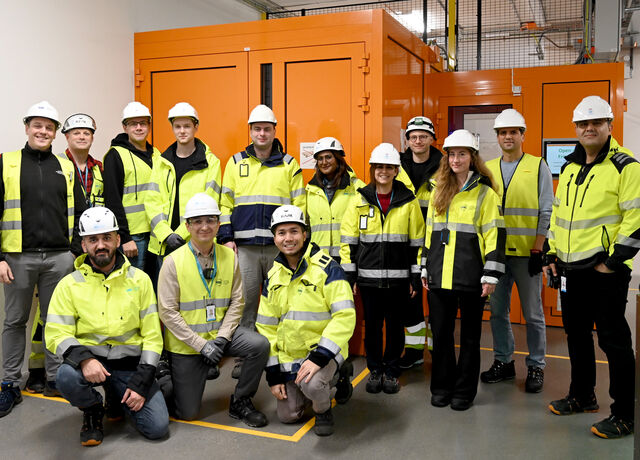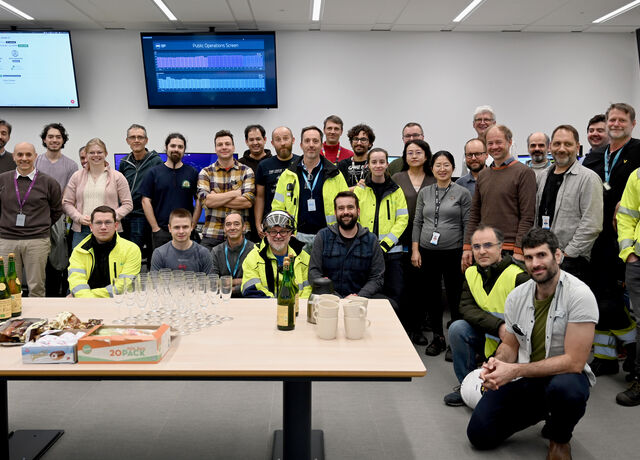General Safety Requirements
At ESS we work to build and operate a state-of-the-art science research facility in a safe and efficient way.
ESS is a European Research Infrastructure Consortium based in Sweden and subject to Swedish Law and Regulations.
Every company doing business with ESS and perfoming work on the ESS site must comply with the general safety requirements outlined below.
Additional requirements may apply, depending on the work to be performed and site areas involved.
Work Environment Responsibility and Coordination |
All contractors have the Work Environment responsibility for their own employees. ESS is responsible for coordinating the Work Environment between the parties.
Risk Assessment and Method Statement |
Before starting to work on the ESS construction site, contractors must provide a description of the work, associated risks and mitigation measures. This information is provided through an ESS Risk Assessment and Method Statement (RAMS) and shall be submitted to ESS at least two weeks prior the start of the work.
ESS Safety and Area Coordinators review the RAMS. Once the information is complete, the RAMS is approved. This is one of the prerequisites for starting the work on site.
Work including the handling and storage of flammables and explosives, such as (gas) bottles containing flammable or oxidising substances, need to be approved by a Flammables and Explosives Officer (FEXO).
Work Orders |
In order to start working on site, every team needs an approved Work Order, which must include the Risk Assessment and Method Statement.
ESS reviews Work Orders on a daily basis. However, it is strongly advised to submit requests between two and eight weeks before the start of the work.
Safety Training |
General training
Everyone working on the ESS site must attend the mandatory Site Safety Induction training, provided by ESS.
Pre-registration is required at least one day prior to arrival.
Job and Area-specific training
Additional training might be required, depending on the hazards related to:
- access to specific areas, including: radiation areas, cryogenics buildings, energised areas - high voltage.
- specific activities, including: hot work, working at height, MEWP (Mobile Elevating Work Platform, such as a scissor lift, sky lift, boom lift), operating forklift, mobile and overhead crane, performing lifting or coupling, work with chemicals.
First Aid and CPR training
It is strongly advised to have one person per work team trained in First Aid and CPR (Cardiopulmonary resuscitation). This training becomes mandatory when working outside of normal working hours.
Incident Reporting |
Everyone working on site must report safety-related incidents, such as: an accident; commuting accident (going directly to work and from work to home); near-miss; risk observation; work-related illness; property/security related incidents, such as theft; environmental incidents, such as spills, pollutions, abnormal noise levels; etc.
Incidents should be reported to the ESS Technical Contact and registered in the online incident reporting system, TIA (from the Swedish "Teknisk Informationssystem om Arbetsmiljö").
Personal Protective Equipment |
The following personal protective equipment is mandatory at the worksite:
- Safety helmet (white for supervisors, blue for site operatives "workers") (EN 397)
- Safety goggles (EN 166). Helmets with visors are not an approved substitute for safety glasses.
- Protective gloves (EN 388)
- Protective shoes (toe cap and puncture-resistant soles) (EN ISO 20345)
- High-visibility clothing on the upper body (Yellow unless other specified) (EN 471 class 2)
- Long trousers
Personal protective equipment must be used to provide adequate protection against ill health and accidents.
The contractor is responsible for providing its personnel with the correct personal protective equipment. The user is responsible for maintaining and storing the equipment to retain its protective properties and hygienic standard.
All personal protective equipment needs to be purchased externally.
Additional personal protective equipment is to be used in accordance with current risk assessments/pre-task planning/safety instructions.
PPE, such as harnesses for working at height, must be inspected regularly.
Chemical Safety |
Hazardous substances may only be used in accordance with the requirements set in the corresponding safety data sheet and the risk assessment related to the work foreseen.
- Contractors must always submit information to the responsible manager for the work (including safety data sheets in English and Swedish) about chemical products/hazardous substances used in their work, and ensure that all individuals who should use these have received sufficient training and information about safe handling according to Swedish legislation.
- Hazardous substances may only be stored on site in dedicated cupboards (to be discussed with the local area coordinator).
- For each hazardous substance to be kept at the construction site, a printed copy of the safety data sheet in English and Swedish must be made available next to the storage cupboard.
- All chemical products or hazardous substances need to be approved, together with the related risk assessment, before they can be used on site. Some may even need to be registered with the Swedish authorities.
Fire Safety |
Hot work may only be executed by individuals with a valid Scandinavian hot work training certificate (Heta Arbeten). Hot work requires a permit from an ESS-authorised permit issuer (the local area coordinator). ESS applies and follows all relevant rules of the Swedish Fire Protection Association (SBF).
Everyone on site must be aware of the location of emergency exits and assembly points, as well as the location of portable fire extinguishers and first aid equipment.
When not in use, gas cylinders are to be gathered outside of buildings in designated areas with posted warning signs. Stored gas cylinders shall be fitted with protective caps; no other equipment may be attached. The cylinders must always be stored upright and be well secured.
Work vehicles are only to be refuelled at designated locations and must be switched off during fuelling.
Electrical Safety |
Every team of contractors needs to appoint an Electrical Safety Leader in charge of the installation work, in collaboration with the ESS Electrical Operation Leader.
At least four weeks before arrival, you shall provide your ESS Reference Person with an Electrical Training certificate, with the content list in English, based on the standard Operation for Electrical installation (SS-EN 50110).
Only licensed electricians, or electricians working under a licensed electrician, may execute work on electrical installations on site.
At least four weeks before arrival, you shall provide your ESS Reference Person with a copy of your authorisation to perform electrical work, as requested by the Swedish Electrical Safety National Board.
More on ESS Rules for Electrical Safety:
- Wherever possible, electrical cables are to be covered or suspended. Covers should not create a tripping hazard.
- All electrical tools, equipment and cords must be checked on a regular basis and, if defective, be taken out of service immediately.
- All electrical installations must be equipped with residual current devices.
- Before any electrical work starts, where there is an electrical hazard, an Electrical Safety Leader shall be appointed in accordance to SS-EN 50110 (ESA-14).
- All electrical work shall be planned with input from a risk assessment for the specific work.
Environment and Waste |
Dust
To avoid exposing anyone to dust, measures are to be taken to reduce or shield work involving dust through pre-task planning and choice of methods, machinery and equipment.
Dust is to be collected or controlled as close to the source as possible, for example, by sprinkling roads, using dust covers on conveyor belts, through integrated dust suction on machinery/tools, by vacuuming floors, using local suction or through water suppression.
Waste management
Measures must be taken to manage waste/rubbish in a suitable manner at each area.
- Waste separation is to be carried out at designated areas according to the site plan.
- Hazardous waste must be separated and handled in accordance with other Accident Prevention Measures.
Other Accident Prevention Measures |
|
Safety barriers and devices
|
Fall prevention/protection
|




























